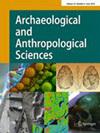Archaeometallurgical investigation on the Han iron swords and knives unearthed from Xi’an, China
Abstract
The iron sword and knife industry was highly developed during the Han dynasties in Chinese history. However, there is not much clarity regarding its presence in the capital. In this paper, we analyzed fragments of seven iron swords and three iron knives excavated in Xi’an city (the capital of Han dynasties) using non-destructive neutron techniques of neutron resonance capture analysis (NRCA) and neutron diffraction (ND) for the first time in China. The results indicate that the hand guards were cast from Cu-Sn-Pb-As alloys, while one knife’s scabbard was made of pure copper. Furthermore, we obtained quantitative results for carbon content, micro-strain and texture effect in different regions of each sword or knife for the first time. This suggests that these iron blades are hypoeutectoid steel, and likely underwent intentional processing such as carburization, decarburizaition and hammering. These findings contribute to a better understanding of the archaeometallurgy related to Han iron swords and knives, which supplements the results obtained from traditional experimental methods. Additionally, it is also significant for further application of neutron techniques in China’s cultural heritage.


 求助内容:
求助内容: 应助结果提醒方式:
应助结果提醒方式:


